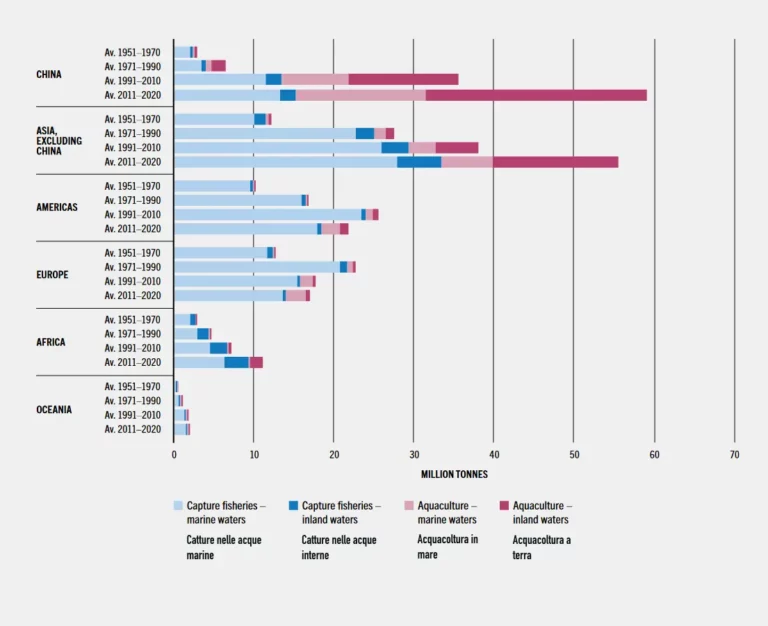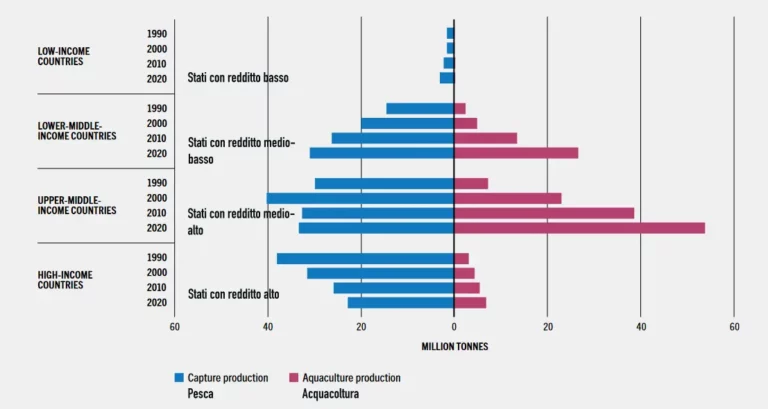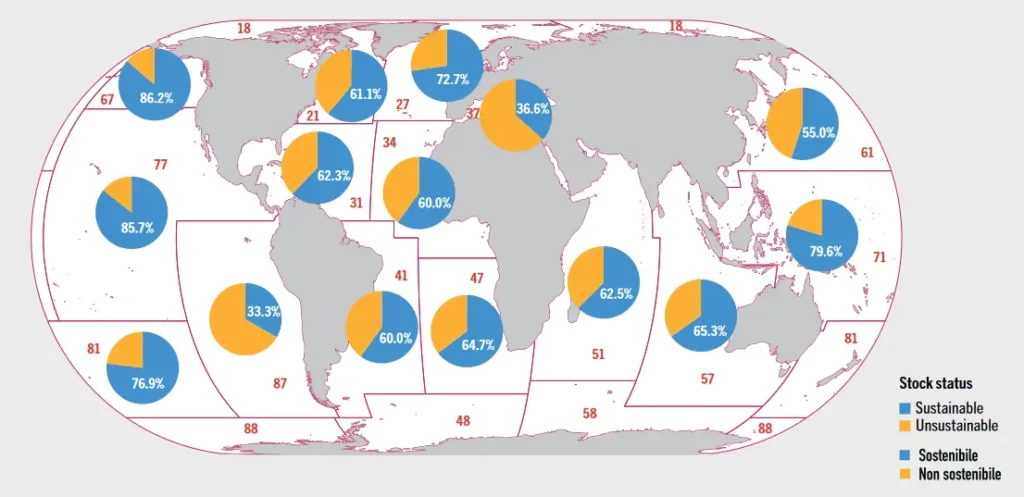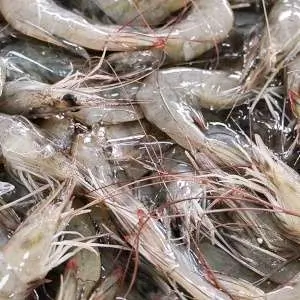Land-based aquaculture as a driver to develop the European rural areas
Can aquaculture become a driver of sustainable development in European rural and coastal areas? When aquaculture is smart conducted, it represents the evolution for humanity and should serve as the primary source of locally farmed sustainable seafood products in Europe
smart aquaculture
The challenges of aquaculture
Global aquaculture focuses on the goal of providing protein for the population, as well as for future surpluses if the predictions of global population growth by the FAO come true. For this reason, most of global aquaculture is already concentrated in Asia.
In Europe, aquaculture in terms of both value and volume can be considered insufficient compared to global production. This is especially evident when we consider the high deficit in the supply balance. European aquaculture should emphasize the environmental impact and organoleptic quality of the product, as well as the development of rural and coastal areas. Additionally, there is a need to reduce dependence on imports to mitigate the failed environmental impact export policy, which has been particularly challenging in European countries due to the negative effects of climate change.


This specialization requires a new husbandry model that minimizes the negative environmental impact, improves the social contexts and have the ability to enter and to force the areas strongly oriented towards tourism, including mass tourism.
Seafood farmers must take into account ongoing climate change and mitigate its effects. According to DINAQUA team, European aquaculture will be increasingly practiced on land in protected environments, also because land-based farming solves the problem of losses caused by the propagation of alien species, as well as guaranteeing optimal growth conditions, together with very precise food safety and product traceability.
Fortunately, Europe has a strong environmental culture. However, mistakes made in the rapid development of global aquaculture can be used as lessons for European aquaculture to avoid unbalanced use of resources so to minimize negative environmental impacts.
We do not doubt the fact that aquaculture is destined to become the only source of supply for seafood products in Europe.
According to the FAO, the stocks in the Mediterranean and Black Seas are second in terms of unsustainable fishing (Area 37), with 63.4% of stocks in distress. According to the General Fisheries Commission in the Mediterranean, the situation is even more dramatic: 73% of commercial stocks in the Mediterranean are captured beyond biologically sustainable limits.

The challenges of rural areas in the EU
The rural regions of the EU have an area equal to 44.6% of the total, and with a population of 93.1 million people (equal to 20.8% of the total EU population), they are multifunctional spaces that are facing a number of challenges, such as an aging population leading to a decline in the number of people of working age, a weak labor market and even depopulation.
Other problems that affect rural areas as opposed to urban ones are the lack of infrastructure and services, a poorly diversified economy, low incomes combined with a higher risk of poverty and social exclusion, the abandonment of agricultural land, the education facilities gap, a high dropout rate and the digital gap (i.e. the lack of reliable internet connections, which is an obstacle for both businesses and people).
All these circumstances have been described as a vicious circle towards rural decline, as more people move to urban areas in search of better job prospects and the provision of public services.
Despite the problems illustrated, rural areas offer a large number of opportunities and their diversity represents one of the EU’s greatest assets. They provide food and environmental resources and can contribute to the fight against climate change by offering alternatives to fossil fuels and developing the circular economy.
These areas play a fundamental role in ensuring a balanced distribution of the population on the territory, thus preventing overcrowding in cities, and guarantee a quality of life that enjoys ever greater appreciation, as well as the contribution that the cultural heritage of rural areas makes to sustainable tourism
The section is the complete quote from the report “Smart small towns: Concept, issues and prospects for EU rural areas”. Research Service for Members PE 689.349 – March 2021. Authors: Ana Martinez Juan and James McEldowney
The section is the complete quote from the report “Smart small towns: Concept, issues and prospects for EU rural areas”. Research Service for Members PE 689.349 – March 2021. Authors: Ana Martinez Juan and James McEldowney
Credits: Cover photo by FORREST CAVALE su Unsplash
Land-based aquaculture: how DINAQUA wants to create the richness of the rural area
In this context, DINAQUA focuses on small and family business and has developed a business model, i.e. RAS smart aquaculture, which offers a new economic model for sustainable development of coastal and rural areas, preserves the national landscape heritage, collaborates with the tourism supply chain – designed as a main customer of the intelligent breeding. The human resources model is based on the identifying and converting existing zootechnics skills of classic terrestrial agriculture, thanks to basis of aquaculture and specific management courses, both for management and for those involved in farming operations.
RAS smart aquaculture farm with an environmental impact similar to floriculture
It is DINAQUA smart aquaculture, i.e. know-how of the farming process including the breeding stage with a specific management model for the secure production that ensures not only the constant control of biomass thanks to the digitized management system with h24 monitoring of the ambience parameters, but also solves the problems related to external biological factors, allowing better growth of the farmed species, very accurate harvest planning, and better earning and economic results
Learn more
the species
The great advantage of DINAQUA’s smart aquaculture is its polyvalence factor, that is the possibility to choose the species to farm, ensuring the shortest ever cash-flow out during the launch stage, for the older stages instead – creating a possibility to respond the eminent market evolution in the future

Tropical shrimps
Shrimp is the second most farmed species globally, with well-known biological cycle, that allows us to manage all risks of the launching stage, especially for those who are making their first experience in the aquaculture sector

European lobster
The farm suites better for seabed species farming, especially in its launching stage. As the European lobster according to EUMOFA is almost completely comes from fishing there is also a huge market opportunity for this species

Oysters with zero costs
We practice Integrated Multi-Trophic Aquaculture, which represents a polyculture system, so oysters, mussels, scallops are farming in the same circuits as the major species, as they are also perfect bioremediators
Learn more
the faq
We’ve identified the most frequently asked questions by our customers in the initial stages of collaboration for the RAS off-land smart aquaculture farm and we propose here the synthetic answers.
If you need further assistance or have any other questions, please don’t hesitate to contact us, we’ll be really happy to help you
Whatsapp chat
What are the requirements for a suitable land piece?
It is sufficient that the land is for agricultural use and relatively flat, with any geological composition, and preferably rectangular with one dimension wider than 60 m. For saltwater projects, it should also be located not far from the coastal zone, within 1.5 km.
What is the scale of investment?
Thanks to the modularity of each farm, investment thresholds can be adjusted to be suitable. Therefore, the business model for three complete investment scales, including both investment data and net margins, is shared from the first meeting upon signing the non-disclosure agreement
I’m new to aquaculture. Would it be a problem?
Most of our clients are making their first entry into the sector, and for some, it’s even their first entrepreneurial experience. Thanks to the range of services developed by our team and in collaboration with our strategic partners, we can provide all the necessary services for the initial stages, as well as for capital raising and long-term assistance. The smart control system has been designed also to manage risks of launch phase, when production is already underway, but the team is still learning to manage the farm. So our goal is to make business together, not just a farm
Are you able to carry out projects outside of Italy?
Yes, we are. We are active throughout the EU and we apply a mixed method of work – thanks to our proprietary digital solutions – with video call meetings aimed at understanding your needs and carrying out all preliminary checks in an absolutely free manner, with an inspection phase in face-to-face meetings to follow
Can I visit any of your smart farms?
Currently, the entire crustacean farming chain is in the capital raising phase, so there is “work in progress”. Obviously, it will be possible to visit the farms in the future with the signing of the non-disclosure agreement and with the inspection phase, therefore with business plan completed for your farm
Do you have a secure supply channel for jivenils?
Certainly, we have. As an integral part of the first italian crustacen supply chain, DINAQUA has committed to creating the National Reproduction Center to guarantee the supply of post-larvae to all smart farms
Need more information about the investment scale?
We will be happy to answer your questions and to satisfy your needs
Call us today via free call-in-cloud↗
Request a free consultation and the crustacean smart farming business model, by filling the contact form↗ or booking a video call meeting↗
contacts

© DINAQUA S.R.L.